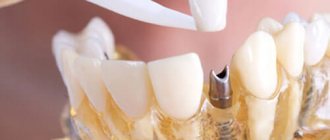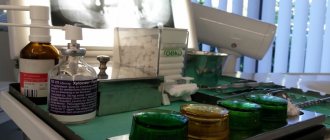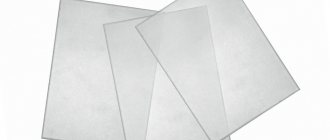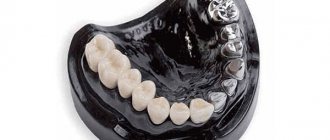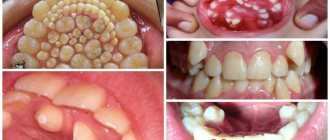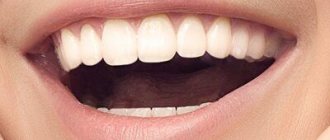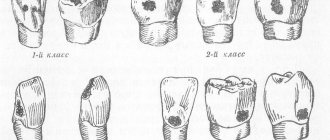Dentistry today works real miracles. Despite this, keeping teeth intact in old age is not so easy. As a rule, older people need prosthetics. At the same time, it is important to choose the right orthopedic design, since at the moment the choice of prostheses is huge. Each material and product has both its advantages and disadvantages. Therefore, it is necessary to proceed from the individual characteristics of the patient, as well as from the clinical picture of his oral cavity.
Types of orthopedic structures
To correctly choose a prosthesis, you need to take into account a number of factors. First of all, the product must fully restore the functions of lost teeth. Also, the choice of the type of orthopedic product depends on the patient’s preferences and financial capabilities. The doctor will tell you which option to choose.
Let's figure out what types of dentures there are.
Main types:
- metal crowns;
- metal-ceramic products;
- ceramic structures.
These products are usually manufactured in two types:
- single crowns;
- bridge structures.
Determining which type of product is better is quite difficult. Each prosthesis has its own characteristics. The main differences are price and aesthetic indicators.
Among other things, dentures are divided into two types: removable and fixed. Let's take a closer look at what removable orthopedic structures are.
Veneers
A special type of crown can be considered veneers - veneers that cover the outer surface of the teeth of the anterior group and restore their shape and color. This design is distinguished by gentle preparation (within the enamel) or its absence at all (lumineers) and use in the so-called. aesthetic zone - the area of the dental arch visible when talking and smiling. The thickness depends on the material, manufacturing technology and clinical situation, varying from 0.3 to 1 mm.
Veneers
Depending on the technology, a distinction is made between semi-direct veneers and indirect veneers. Both varieties are made on a model in the laboratory (in the first case, from a clinical composite (which is used for “fillings”), in the second, from laboratory material). Temporary veneers are made of plastic and are used to protect prepared teeth and provide aesthetic correction while permanent ones are being made.
Indications for use:
- Changes in tooth color (discoloration);
- Tooth surface defects – stained cracks, non-carious lesions extending beyond the middle of the vestibular surface;
- Gaps between teeth (diastema, tremata) – if you do not want orthodontic correction or as a relapse of treatment;
- Dental trauma (crown angle fracture);
- Abrasion along the cutting edge.
Contraindications for use:
- Inability to preserve more than half of the enamel during preparation or severe damage to the crown;
- Teeth with removed pulp;
- Parafunctions of the masticatory muscles – non-functional contractions (grinding, clenching);
- Pathological types of bite;
- Carious lesions and/or fillings/restorations;
- Temporary teeth;
- Poor oral hygiene;
- Hereditary inferiority of the enamel structure;
- Acute or exacerbation of chronic diseases of the oral cavity, accompanied by the formation and release of inflammatory fluid (temporary).
Manufacturing methods:
- Injection pressing followed by sintering of ceramic mass (Dicor, IPS Empress);
- Vacuum firing on a refractory model (refractor);
- Milling on a computer-controlled machine from ready-made factory blocks - CAD/CAM (computer aided design and manufacturing) - Cerec, Everest Procera, Cercon systems and In-Ceram, Vollceram, Hi-Ceram masses.
Being a type of crown , a veneer has almost identical advantages and clinical and laboratory manufacturing stages. Due to the special aesthetic value of the anterior part of the dentition, it is advisable to follow a photo protocol, which involves capturing the image of the patient’s face in front and profile, a smile, the nature of the closure of the dentition in the anterior part, and each of them separately against a contrasting background. This information is useful for the clinician and especially the technician for the purpose of planning this type of construction.
Caries , increased abrasion or trauma often lead to almost complete destruction of the crown of the tooth while preserving its root or roots. Restoration of a tooth crown in its absence is carried out using artificial crowns on cast stump pin inlays - LKSHV. This design consists of a pin cemented in the prepared part of the root canal and an artificial stump. They are cast in a single solid from gold, silver-palladium or cobalt-chrome alloy.
Root requirements for prosthetics:
- Good channel permeability throughout its entire length;
- Hermetic filling of the apical part and absence of pathological changes around the root;
- Sufficient length (twice as long as the crown);
- Sufficient wall thickness to withstand chewing pressure and their hardness;
- Root resistance;
- The presence of a supragingival part of at least 2 mm.
Design advantages:
- The ability to replace an artificial crown without the need to remove the pin (this compares favorably with previously used pinned teeth, in which the artificial crown and stump were one whole);
- The ability to use a stump to support a bridge when removing an adjacent tooth;
- Possibility of prosthetic bridge prosthesis for defects limited by the roots (if the channels and pins are not parallel, it is possible to apply a prosthesis due to the parallelism of the walls of the stumps).
After creating an artificial stump with a pin and fixing it in the root canal in the usual way, the whole complex of measures and manipulations is carried out in accordance with prosthetics with artificial crowns .
Which removable denture is better to install?
First you need to understand what kind of design is required. Removable orthotics come in two main types: partial and complete removables.
In turn, each of these types is divided into various types, differing from each other in material of manufacture and functional features. The choice of the necessary orthopedic design mainly depends on how many teeth there are in the patient’s mouth.
Complete dentures
If there is a complete absence of teeth on one or two jaws at once, the patient is offered to have complete removable dentures installed. In addition to standard plate-based removable structures, there are also nylon dentures.
Structures made using modern methods are stronger and more durable, as well as aesthetically more attractive. With proper care and following your doctor's recommendations, dentures can serve you for many years, maintaining their original appearance and function.
Secure fixation
One of the main criteria when choosing a design is the reliability of its fixation in the oral cavity. If we talk about removable structures, the most reliable way to fix them is to install the prosthesis on implants, which are pre-screwed into the jaw bone. The disadvantage of this type of prosthetics is the high cost of dental implants.
In order to decide which version of the product to choose, you need to understand what advantages and disadvantages the design has.
Features of a nylon prosthesis
- Elasticity of the structure. Thanks to the material from which they are made, the dentures are very soft, light and flexible.
- Hygiene. Nylon dentures do not emit any odor and do not absorb moisture, so there is no accumulation of bacteria on their surface.
- Appearance. Nylon structures look very natural, matching the natural shape and color of teeth. In addition, they retain their aesthetic appearance for several years.
- Hypoallergenic. Nylon structures are biocompatible with the human body and therefore do not cause any allergic reactions.
- The disadvantages of nylon dentures include the presence of small gaps at the junction of the teeth.
Partially removable structures
If several teeth are lost, one of the options for restoring them is partial dentures. Such structures are made from a plastic base or metal frame. The main types include: plastic partially removable dentures, clasp partially removable structures and nylon orthopedic products.
Features of plastic plate structures
Plate dentures are the simplest option for restoring missing teeth. They are used both as a permanent orthopedic structure and as a temporary prosthesis. Such designs are quite easy to use and also have a low cost. The disadvantage of such designs is the long period of getting used to the prosthesis.
Clasp designs
Clasp dentures are easy to use, reliable and durable even with a long service life. Their main advantage is the correct distribution of the chewing load.
The basis of the clasp prosthesis is a frame in the form of a metal arc with elements for fastening. The prosthesis can be attached using hooks or locks that cling to the remaining teeth. The frame is made of high strength alloys.
Orthopedic structures that do not require removal
Fixed orthopedic products that can be used for the loss of one or several teeth include:
- crowns;
- bridge products;
- tabs;
- veneers;
- prosthetics on implants.
Orthopedics in dentistry
Valgus deformity
01.07.18
Asked by: Alena
Hello, I have a hallux valgus deformity of my right foot, my big toe, my left foot has been operated on. are you dealing with this problem?
Answer:
Good afternoon, Alena! Yes, we are looking into this problem. Make an appointment for your next appointment with all available medical documentation.
Which doctor should I go to?
19.06.18
Asked by: Dmitry
Hello. My knee has been hurting for several months (acute spasmodic pain under the kneecap on the inside in the “depression”; if you press with your fingers, this place is sensitive, but does not hurt). It is especially felt when walking up stairs, as well as when riding a bicycle. There is almost no pain when walking and running. Although sometimes (a couple of times a day) a spasm occurs just like that, for example, when sitting on a chair or in a dream. I am 42 years old, have a sedentary job, am overweight, have flat feet since childhood. The real question is: which doctor should I go to? Thanks in advance.
Answer:
Dmitry, you need to make an appointment with a traumatologist-orthopedist. After a visual examination, the doctor will decide on further actions and prescribe diagnostics and treatment for you.
Knee block
31.05.18
Asked by: Marina
Good afternoon. My mother is 85 years old. A bunch of diseases, including type 2 diabetes and coxoarthrosis of the knee joints. My legs hurt a lot, there is severe swelling, we want to do a blockade. Can this be done in one visit to the doctor and what studies do you need to have on hand for this? And is it possible to decide on the drug in advance? Thank you.
Answer:
To determine treatment tactics, a face-to-face consultation is necessary, during which questions about the indications for blockades and the choice of drugs will be determined. Theoretically, the blockade can be performed on the day of administration. For admission, R-grams of diseased joints and all medical documents that are available are required.
The child's feet hurt
12.04.18
Asked by: Julia
The child is engaged in figure skating and began to complain of pain on the side of her foot, as if a bone was growing. We went to an orthopedist; she didn’t find anything critical; just in case, she sent me for an x-ray. They did it in two projections with a load, the results are strange. Arch 148 degrees right, 147 left, arch height 21 degrees, talus equinus-115 degrees left, 117 right, metatarso varus left 26 degrees, 25 right, 1-2 mold bones left 10 degrees, right-7 degrees, Halux Valgus left 23 degrees, right 15 degrees. The orthopedist's conclusion was: scoliotic posture, instability of the arches of the feet, sesamoid bones under the? . Radiologist's conclusion: longitudinal flatfoot, degree 2. Halux valgus 2 degrees on the right, supernumerary scaphoid and talus on the left. Please tell me how bad this diagnosis is and whether we can continue skating.
Answer:
Julia, good afternoon!
1. To fully understand the situation, it is necessary to know the age and gender of the child.
2. It is possible to give precise recommendations on sports activities only after an in-person examination.
3. It is necessary to engage in the prevention and treatment of flat feet: use individual orthopedic insoles, regular exercises for the feet, electrical stimulation of the internal (medial) muscle group of the lower leg, massage.
X-ray when installing braces
10.02.10
Asks: Olya
I want to get braces. Is it possible to do without an X-ray of the jaw or is it necessary?
Answer:
Hello! This is almost always necessary.
Dentistry "My Dental" - close, high quality, inexpensive.
| Treatment |
| More details |
| Removal |
| More details |
| Prosthetics |
| More details |
| Implantation |
| More details |
| Cleaning |
| More details |
| Braces |
| More details |
| Whitening |
| More details |
| Children's |
| More details |
Can dental treatment be painless?
We say with confidence: - Yes! Unfortunately, many people have had experience communicating with a dentist in a public clinic. And almost everyone remembers the fear that accompanied us every time we visited the doctor. To our great joy, everything has changed dramatically now:
- New needles for administering anesthetic have become several times thinner, which makes it possible to “make an injection” almost painlessly, and in some cases it is possible to use topical anesthesia (the site of the future injection is treated with a special anesthetic gel, which makes the injection even less noticeable)
- New generation anesthetics - for example, Ultracaine - are an order of magnitude superior to the previously used Novocaine. This allows pain relief to be so effective that some patients manage to fall asleep during dental treatment.
- Attentive and caring attitude towards the patient - forget the word “endure”! If painful sensations appear, the doctor will definitely ask if everything is okay, will be more careful, and will also suggest adding an anesthetic.
All this allows even the most timid to part with the past fear of going to the dentist!
Doesn't the quality of dental services decrease at such low prices?
No, inexpensive dentistry does not mean low-quality. Our doctors treat teeth with high quality, using all technologies, so all types of work are guaranteed.
Prices for dental services will please our patients. Moreover, consultations with all specialists are free, and the cost of an X-ray is significantly lower than the average price in the city. We don’t want people to delay their treatment due to lack of finances - after all, health should be accessible to everyone. That's why we have very profitable promotions, which you can find out about here.
The quality of our work can best be told by the reviews of our patients - for them, “My Dental” is rightfully the best dentistry in St. Petersburg.
What types of services do we provide?
- Treatment of caries. Our main task is to save the tooth. High-quality filling using imported materials. We guarantee that the filling will last you a long time! Note: the warranty on all types of fillings is 12 months.
- Dental prosthetics. The prosthetic methods used make it possible to completely restore the chewing function of the teeth, while maintaining the beauty of the smile and comfort when using the prosthesis. All types of prosthetics are also guaranteed.
- Implantation. Properly installed implants will last you more than 10 years. The advantages of this modern type of prosthetics are: there is no need to grind adjacent teeth and the possibility of immediate implantation during tooth extraction. In appearance, implants look and function exactly like your healthy teeth. All types of implantation are also guaranteed; moreover, if the implant is rejected (probability 0.01%), replacing the old implant with a new one is free of charge.
- Bite correction. A beautiful smile is the key that opens almost any door. Modern braces allow you to correct your bite at almost any age.
- Professional teeth cleaning. An inexpensive procedure that allows you to get rid of unpleasant odor, plaque or tartar, as well as darkening of teeth from smoking, coffee, etc. In addition, this procedure significantly reduces the likelihood of caries.

